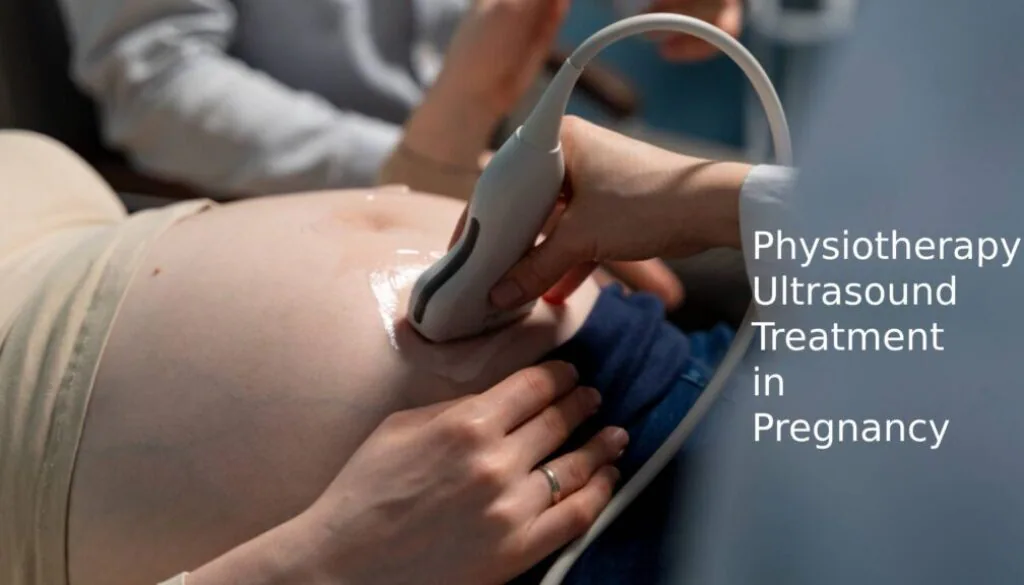Physiotherapy Ultrasound Treatment in Pregnancy
Pregnancy is a beautiful journey, but let’s be honest—it’s also a time when your body throws you into a whirlwind of aches, pains, and unexpected discomforts. As the baby grows, your body starts adjusting in ways that can cause significant physical strain. Enter physiotherapy—a go-to remedy for many pregnant women. But did you know that ultrasound therapy, a form of physiotherapy, can also offer gentle yet effective relief during pregnancy?
Now, before you get alarmed or visualize the diagnostic ultrasound used in prenatal checkups, hold up. We’re talking about therapeutic ultrasound, which works on a completely different wavelength—literally and figuratively. In this comprehensive guide, we’re diving into how physiotherapy ultrasound treatment works during pregnancy, its safety, what conditions it can treat, and why it might just be the relief you didn’t know you needed.
Let’s unpack everything step-by-step, so you can make informed decisions for a healthier, more comfortable pregnancy.
Introduction to Physiotherapy During Pregnancy
Why Physiotherapy Matters in Prenatal Care
Pregnancy is no less than a marathon, emotionally, mentally, and physically. Your body undergoes massive changes, like hormonal shifts, ligament loosening, weight gain, and postural changes. These can cause discomfort ranging from mild aches to severe pain that interrupts sleep, affects mobility, or even leads to long-term issues if ignored.
Physiotherapy is a gentle, noninvasive, and drug-free way to manage these physical transformations. Physiotherapists trained in prenatal care design customized programs focusing on posture correction, core strength, flexibility, and pain relief. And what’s amazing? Many of these techniques are safe throughout all three trimesters.
It’s not just about pain management either. Physiotherapy helps you prepare your body for labor, improves blood circulation, reduces swelling, and supports emotional well-being by keeping stress hormones in check. You’re not just treating symptoms; you’re optimizing your body for a smoother pregnancy and postpartum recovery.
Common Pregnancy-Related Discomforts Treated with Physiotherapy
So, what exactly does physiotherapy target during pregnancy? A whole range of conditions, including:
- Lower back pain: One of the most common complaints as the baby bump grows.
- Pelvic girdle pain (PGP): Caused by instability in pelvic joints due to hormone relaxin.
- Sciatica: Nerve pain shooting down your leg, thanks to pressure on the sciatic nerve.
- Carpal tunnel syndrome: Swelling and pressure in the wrist due to fluid retention.
- Swelling and edema: Physiotherapy techniques can improve lymphatic drainage.
Each of these conditions can be managed without the need for medications, making physiotherapy a preferred choice for moms-to-be who want to avoid pharmaceuticals.
What is Ultrasound Therapy in Physiotherapy?
The Basic Mechanism Behind Ultrasound Therapy
Ultrasound therapy in physiotherapy is completely different from the prenatal ultrasound you might be familiar with. While diagnostic ultrasound creates images, therapeutic ultrasound uses sound waves to create a deep heating effect in tissues like muscles, tendons, and ligaments.
Here’s the science in simple terms: A handheld device called a transducer is moved over the affected area. This device emits high-frequency sound waves that penetrate the skin, reaching deep tissues. These waves cause tiny vibrations in the tissue, which generate heat or stimulate cellular activity, depending on the settings used.
The result? Reduced pain, increased blood flow, quicker healing, and improved flexibility. It’s like relaxing your internal tissues, but way deeper.
Types of Ultrasound Used in Physiotherapy
Thermal vs. Non-Thermal Ultrasound
- Thermal ultrasound heats up the tissues to increase blood flow, loosen muscles, and reduce stiffness.
- Non-thermal ultrasound, on the other hand, doesn’t create heat but promotes cellular repair by increasing the permeability of the cell membranes. It’s mostly used for inflammation, edema, or acute injuries.
Pulsed vs. Continuous Mode
- Pulsed ultrasound delivers waves intermittently, minimizing heat and making it safer for sensitive conditions—ideal during pregnancy.
- Continuous ultrasound provides a steady stream of waves, typically used in chronic conditions that require deeper heating.
For pregnant patients, the pulsed, non-thermal setting is often preferred, especially when targeting musculoskeletal pain in areas far from the uterus.
Safety of Ultrasound Therapy in Pregnancy
Can Ultrasound Therapy Be Safely Used During Pregnancy?
One of the biggest questions expectant mothers ask is: “Is ultrasound therapy safe while I’m pregnant?”
The short answer is yes—when used correctly and cautiously. Therapeutic ultrasound is generally safe during pregnancy when the treatment area is away from the abdomen and uterus. Trained physiotherapists are fully aware of these precautions and avoid using ultrasound near reproductive organs.
The risk arises only when ultrasound is misapplied, such as using thermal modes near sensitive or contraindicated zones. This is why it’s critical to work with a certified prenatal physiotherapist.
Guidelines from Health Authorities and Medical Bodies
Most health authorities, including the Chartered Society of Physiotherapy and American College of Obstetricians and Gynecologists, agree on the safety of localized, controlled ultrasound treatment in pregnant women under professional supervision.
Here are some standard safety guidelines:
- Never use ultrasound over the uterus.
- Avoid bony areas with poor circulation.
- Limit exposure time and use pulsed modes.
- Always confirm with your OB-GYN before starting any therapy.
It’s about being smart and safe—not fearful. When used wisely, ultrasound therapy can be a real game-changer in prenatal care.
Conditions Treated with Physiotherapy Ultrasound in Pregnant Women
Lower Back Pain and Pelvic Girdle Pain
Back pain during pregnancy is so common it’s practically expected. Your spine has to carry extra weight, your posture shifts, and ligaments loosen up—all leading to discomfort. Physiotherapy ultrasound can provide targeted relief by reducing inflammation and improving blood flow in the lumbar and pelvic region.
But here’s the important part: ultrasound isn’t applied directly on the spine or pelvis in pregnant women. Instead, physiotherapists work around safe zones like the glutes, upper thighs, or lower lumbar muscles to alleviate tension and pain. This approach is particularly useful in managing pelvic girdle pain (PGP)—a debilitating condition caused by instability in pelvic joints.
Ultrasound therapy can also be combined with pelvic floor exercises and manual therapy for a holistic approach.
Sciatica and Nerve-Related Pain
Sciatica is another all-too-common pregnancy woe. As the uterus expands, it can put pressure on the sciatic nerve that runs from the lower back down through the hips and legs. This pressure can result in sharp, shooting pain that radiates down one side of the body. Not only is it painful, but it can also be disabling, affecting sleep and daily movement.
Physiotherapy ultrasound helps by targeting the surrounding tissues of the sciatic nerve—not the nerve directly. The pulsed ultrasound waves reduce muscle spasms and inflammation in the lower back, glutes, and hamstrings, which in turn relieves pressure on the nerve. Plus, the gentle warmth helps muscles relax, improving mobility and reducing sharp, stabbing sensations.
It’s important to note that therapists avoid the central lower back and pelvic regions to ensure fetal safety. The treatment zones are carefully selected to be both effective and safe. This therapy is often paired with stretching routines and posture correction exercises to keep the sciatic pain at bay long-term.
Soft Tissue Injuries and Swelling
Pregnancy can make your body more susceptible to soft tissue injuries. With the hormone relaxin making your ligaments more flexible, joints can become unstable. That, combined with the extra weight and shifting center of gravity, increases the risk of muscle strains, tendonitis, and joint pain.
Ultrasound therapy offers an excellent way to treat these soft tissue problems. The high-frequency sound waves penetrate deep into muscles and tendons, stimulating cell repair and reducing inflammation. This helps speed up the recovery process without needing medication.
Swelling—especially in the ankles, feet, and hands—is another concern during pregnancy. Ultrasound in pulsed mode encourages lymphatic drainage and blood circulation, helping the body get rid of excess fluids. Many pregnant women report significant relief from pain and heaviness after a few sessions.
Of course, proper hydration, limb elevation, and compression therapy can also help, but ultrasound provides a powerful supplement to these remedies, minus the side effects.
Benefits of Using Ultrasound Therapy During Pregnancy
Pain Reduction and Muscle Relaxation
Let’s talk about comfort—because, let’s face it, pregnancy can be rough on your muscles. Whether it’s your aching lower back, sore legs, or tense shoulders, pain seems to pop up everywhere. Ultrasound therapy can work wonders by offering deep tissue relief without needing painkillers.
The pulsed ultrasound waves penetrate deep into muscle fibers, triggering warmth and increased blood flow. This warmth encourages tense muscles to relax, while the improved circulation helps flush out pain-causing chemicals like lactic acid. It’s like giving your overworked muscles a warm bath from the inside.
Unlike heating pads that only work on the surface, ultrasound therapy targets the root of the pain beneath the skin. The result? Fast, effective relief that lasts longer and doesn’t come with the risks associated with medications.
Pregnant women often report feeling looser, lighter, and more mobile after just a few sessions. It’s a non-invasive way to feel human again when everything else is stretching, shifting, and swelling.
Accelerated Tissue Healing
Pregnancy puts your tissues through a lot. From overstretched ligaments to tiny muscle tears caused by sudden movements, your body is constantly in repair mode. And when you’re limited in the kinds of treatments you can safely use, recovery can take longer.
Here’s where ultrasound therapy truly shines. The vibrations produced by ultrasound increase cell membrane permeability. This allows essential nutrients, oxygen, and white blood cells to flood the injured area faster, speeding up the natural healing process. Think of it as giving your body’s repair crew a VIP pass to the scene of the damage.
This effect is especially useful for managing chronic conditions or lingering injuries that just won’t heal on their own. By helping tissues recover more quickly, ultrasound therapy lets you stay more active and pain-free throughout your pregnancy. And being active is key, not just for your own health, but for a smoother delivery and postpartum recovery.
Enhanced Mobility and Quality of Life
Mobility is everything during pregnancy. You want to be able to bend, walk, sit, sleep, and go about your day without feeling like your body is betraying you. Unfortunately, pain and stiffness can make even basic movements feel like a chore.
That’s where ultrasound therapy steps in, not just to reduce pain, but to restore mobility and make life feel normal again. By loosening tight muscles and reducing joint inflammation, it helps you can move more freely. This means fewer sleepless nights, easier workouts, more energy, and less frustration.
Physiotherapists often combine ultrasound with stretching routines, stability exercises, and ergonomic advice. This holistic approach doesn’t just treat the pain, it gives you tools to maintain comfort and mobility long-term.
The bottom line? Ultrasound therapy is about more than just temporary relief. It’s about enhancing your overall quality of life during pregnancy so you can focus on what matters, preparing for your little one.
How Physiotherapy Ultrasound Complements Other Prenatal Therapies
Integration with Manual Therapy and Exercise
Physiotherapy isn’t a one-trick pony, it works best when different treatments are combined to maximize comfort and healing. Ultrasound therapy, for instance, is often used alongside manual therapy and tailored exercises for expecting moms. This holistic blend helps tackle musculoskeletal problems from multiple angles.
Manual therapy includes hands-on techniques like soft tissue massage, myofascial release, and joint mobilization. These methods reduce tension, improve posture, and restore joint mobility. Once manual therapy releases tight areas, ultrasound can then be used to target deep tissues and promote healing in those zones.
Then comes the exercise part—another critical pillar. Gentle prenatal stretches, core strengthening, and pelvic floor exercises work synergistically with ultrasound therapy to maintain body balance, support joints, and prevent recurring pain. This integrative approach ensures that treatment isn’t just reactive but preventive as well.
The result? A healthier, more mobile pregnancy experience with reduced reliance on medications or interventions.
Personalized Physiotherapy Plans for Pregnant Women
No two pregnancies are alike, and neither should be the treatment plans. A major benefit of working with a trained prenatal physiotherapist is that they tailor each therapy session, including ultrasound, to the specific needs of the mother.
Whether you’re dealing with lower back pain, pubic symphysis dysfunction, or upper body tension from breastfeeding prep, your physiotherapist will adjust the intensity, location, and duration of ultrasound therapy accordingly. They’ll also consider your trimester, overall health, and any underlying conditions to keep things safe and effective.
Pregnancy is unpredictable; what works one week might not the next. That’s why ongoing reassessment is crucial. Therapists monitor your progress and tweak treatment plans to ensure the best outcomes for both mom and baby.
This personalized approach takes the guesswork out of managing discomfort. You’re not just getting care, you’re getting care that fits you perfectly.
Precautions and Contraindications of Ultrasound in Pregnancy
While therapeutic ultrasound is considered safe when used correctly, it’s not a free-for-all. There are strict precautions and contraindications that must be observed to keep both mom and baby safe.
Some important safety measures include:
- Avoiding direct application near the abdomen, uterus, and lower back.
- Never using ultrasound over areas with open wounds, infections, or thrombosis.
- Avoiding bony prominences or areas with poor circulation.
- Not using thermal modes in early pregnancy or near reproductive organs.
It’s also crucial to avoid DIY therapy tools or sessions from untrained providers. Always ensure that your physiotherapist is certified in prenatal care and understands the specific protocols for pregnancy.
In short, therapeutic ultrasound is incredibly effective—but only when administered by professionals who know the ins and outs of prenatal physiology.
When to Start and How Often to Use Ultrasound Therapy
Wondering when it’s the right time to begin ultrasound therapy during pregnancy? The truth is, there’s no one-size-fits-all timeline—but many women benefit from starting in the second trimester when physical changes become more pronounced.
If you’re experiencing muscle soreness, joint stiffness, or nerve pain that isn’t resolving with stretching or light exercise, your physiotherapist might suggest a trial of ultrasound therapy. In most cases, sessions are scheduled 1–2 times per week, with reassessment every few sessions.
Each session usually lasts 10–15 minutes, depending on the area treated and the intensity used. As you progress, the frequency may be reduced, or therapy may be paired with more exercise-based rehabilitation.
Early treatment often means fewer complications down the line. So if you’re dealing with persistent pain or limited mobility, don’t wait until it worsens—get proactive.
Final Thoughts: Empowering Pregnancy with Safe Physiotherapy Solutions
Pregnancy is a time of transformation—beautiful, yes, but often accompanied by physical challenges that can affect your quality of life. Fortunately, physiotherapy, and particularly ultrasound therapy, offers a safe, effective way to manage pain, support healing, and boost mobility without drugs or invasive procedures.
When administered by skilled professionals, ultrasound therapy is not just safe—it’s powerful. From relieving sciatica to easing back pain and reducing inflammation, it helps you feel more in control of your body during a time when everything else seems to be changing.
The key is to stay informed, communicate with your healthcare team, and invest in supportive therapies that prioritize both your well-being and your baby’s safety. After all, a more comfortable pregnancy leads to a more empowered mom—and a smoother transition into motherhood.



